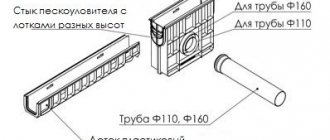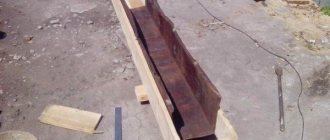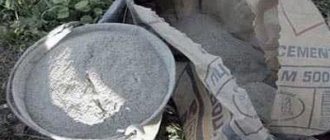Reinforced concrete trays for water drainage are widely used in all areas of construction; they are used in the construction of residential, industrial and administrative buildings, as well as highways, garages, parking lots and even greenhouses.
The main purpose of reinforced concrete trays is to conduct water. Rain and drainage systems usually run inside the tray. Ensuring water flow through the underground communications system allows for more efficient use of the facility area.
Features of drainage trays
Today, plastic pipelines are very often used. However, PVC products are not always suitable for draining water, because they are difficult to withstand temperature changes. For this reason, concrete structures are more relevant. They are created in accordance with GOST 21509–76 . We are talking about main guides, thanks to which water drainage is ensured. Such products, as well as drainage wells and some additional elements, make it possible to create a truly practical outdoor sewage system.
Many consumers prefer concrete trays due to their advantages:
- resistance to corrosion;
- ability to withstand sudden temperature changes;
- maintaining integrity even when the water in the gutter freezes;
- the ability to make a drainage tray yourself;
- service life is about 50 years;
- availability.
As mentioned earlier, all drainage trays are manufactured taking into account GOST. This document specifies the basic requirements for the creation and placement of structures, as well as their dimensions.
Types and sizes of reinforced concrete trays
There are two types of products for “transporting” water: Irrigation system trays and road drainage trays equipped with protective grilles. According to the name, the first type of product is used for the construction of irrigation systems for agricultural areas, and the second type is used to ensure rapid drainage of rain and melt water from highways, highways, city roads and pedestrian sidewalks.
The main characteristics and dimensions of trays for irrigation systems are regulated by GOST 21509-76 “REINFORCED CONCRETE TRAYS FOR IRRIGATION SYSTEMS”, and the main characteristics and dimensions of products for completing drainage systems for roads and pedestrian crossings are regulated by the regulatory document GOST 32955-2014 “Road drainage trays”.
Reinforced concrete drainage trays GOST 21509-76
Trays of this type are designed for the construction of irrigation systems designed to pump water in quantities of up to 5 cubic meters per hour. The product is a reinforced concrete parabolic trench of certain dimensions, which can be installed on supports or slabs, or laid in the soil.
Depending on the installation method, trays for irrigation systems are marked as LV or LRG. LV trays are installed on supports or slabs, and LRG products are laid directly into the soil.
An example of the designation of a reinforced concrete drainage channel of the LV series with a height of 400 mm: LV4. Precast concrete factories offer for sale the following types and dimensions of trays for the construction of irrigation systems, shown in Table 1.
Table 1
| Designation | Overall dimensions, mm | Weight, kg | |||
| Length | Height | Width | Wall thickness | ||
| LR4 | 5980 | 400 | 908 | 50 | 1080 |
| LRG4 | |||||
| LR6 | 600 | 1084 | 1420 | ||
| LRG6 | |||||
| LR8 | 800 | 1240 | 60 | 1920 | |
| LRG8 | |||||
| LR10 | 1000 | 1804 | 75 | 3310 | |
| LRG10 | |||||
Reinforced concrete drainage trays GOST 21509-76 are made of heavy concrete grade M300, reinforced with steel reinforcement. To allow assembly into a single system and installation on supports (plates), each product is equipped with embedded parts for welding and a parabolic recess for laying the seal.
Reinforced concrete drainage road trays GOST 32955-2014
Products of this type are used to receive surface water for further direction to sewerage systems. This refers to wastewater coming from the roadway, sidewalks, roadsides or soil surface.
At the same time, in accordance with the requirements of the regulatory document, the design of drainage products is a set - a reinforced concrete drainage tray with a grate made of cast iron.
The regulatory document defines settling structural types of road drainage gutters: box-shaped, slotted, open, rectangular, U-shaped, curb, ring and other types.
At the same time, trays can be manufactured either at reinforced concrete factories and delivered to construction sites ready for installation, or they can be manufactured directly at construction sites by pouring reinforced concrete.
GOST 32955-2014 does not regulate the rigid dimensions of reinforced concrete road drainage trays. Buyers are offered a wide selection of tray dimensions depending on specific tasks and the length of the drainage line:
- Length from 400 to 4,000 mm or more.
- Width from 500 mm or more.
- Height from 200 mm or more.
Specific dimensions of trays and gratings may differ from GOST standards. In other words, the dimensions, configuration, types of road drainage trays and grates are specified in the designs of specific structures. As in the previous case, for the manufacture of road trays, heavy reinforced concrete grade M300 is used, prepared with cement of a grade not lower than TsEM I 32.5N PTs.
Types of concrete trays
In the manufacture of such drainage structures, the pressing method is used, due to which the finished concrete products are truly durable. In some cases, metal is additionally used. Such ready-made reinforced concrete trays are more durable, but too expensive, which is why they are used infrequently.
All concrete trays are classified according to load class .
- The C 250 is designed for roads with medium and low traffic volumes. Often such products are installed in small parking lots for passenger vehicles.
- D 400 are designed for high traffic roads. These can also be places where garages accumulate and areas where gas stations are located.
- The E 600 is installed on highways and railways.
- F 900 are used to drain water from the areas of large logistics centers and airports.
In domestic construction, it is pleasant to use concrete trays belonging to class C 250. They satisfy all requirements and are sold at an affordable price.
There is another classification of concrete products, which differ in their size and shape .
- The bait variety has a minimal diameter, which means that it can be used to remove small flows of water. As a rule, such products are installed when organizing a drainage system near the house.
- Garage structures have a maximum height of 10 cm. Most often they are installed in areas where there is not too much water. The advantage of this option is the presence of smooth walls. Accordingly, the product will not clog, even if there is a lot of dirt in the water.
- The cottage variety has a depth of 15 cm, which means its efficiency will be higher. For additional protection, the structure is usually covered with a special lid.
- Road trays are used in the presence of constant loads. Here the working depth is at least 19 cm. This option has an important advantage: when the load exceeds the maximum permissible norm, the drainage system will bend only at a certain point, which means that the external sewage system will work effectively even in difficult conditions.
- The channel variety is called intersleeper. Its depth reaches 30–60 cm. Such gutters are relevant not only on railways, but also in areas where swampy soil predominates.
Separately, it is worth mentioning telescopic drainage trays . According to GOST, they can have various forms. This variety will be the best solution for areas located on a slight slope.
Tray production
In the manufacture of a reinforced concrete drainage tray, cement of a grade no lower than M300 is used, mixed from high-quality ingredients, as well as steel reinforcement of classes A-1 and A-3, as well as BP-1. If trays are made for soil that is aggressive to concrete, sulfate-resistant cement is used in production.
Trays are produced in the following batches:
The starting materials for the manufacture of concrete, from which the tray will subsequently be cast, must meet the requirements of GOST, for example, they should not contain particles larger than 15 mm, and the grade of Portland cement should not be lower than 400.
It is prohibited to use for production:
For the production of unstressed trays, hot-rolled steel with a diameter of 6 mm of class A-3 should be used.
Installation of concrete trays
Many people prefer to install drainage trays themselves. To do this, you must first select a suitable scheme. It may differ depending on the selected class of concrete product.
Preparatory work is considered equally important . Thus, design documentation should be developed, which will mention the main elements of drainage and their location. Next, you need to mark the area and select the place where the inlet valve, sand trap and other additional equipment will be installed. After this, it is important to prepare the concrete trays and other important elements.
As soon as everything is ready, you need to start installation .
- According to the markings, you need to dig a trench. Its dimensions should slightly exceed the dimensions of the concrete trays, thanks to which it will be possible to compact the structure with crushed stone and sand.
- Concrete is laid on top of the compacting layer.
- Trays are then placed in the center of the trench.
- The structure is reinforced on both sides with concrete pads.
- The individual elements are secured to each other using appropriate groove connections. If desired, the joints can be treated with acrylic sealant.
- Each drainage tray is covered with a grid, so that leaves, dirt and debris do not get into the system.
- The last stage involves checking the functionality of the system. Only after this can it be connected to the sewer.
Installation features
To avoid clogging of drainage trays during their operation, these structures are usually located under reinforced concrete floor slabs. When laying reinforced concrete trays in a trench and joining each other, they are coated with a waterproofing agent to protect the structure from the aggressive effects of the soil and extend its service life. To protect the structure from temperature changes, thermal shields are used.
Tunnels from reinforced concrete trays are laid quite quickly. They are practical and convenient for inspection: if necessary, the soil can be excavated and the channel itself and the pipes running inside can be inspected by simply lifting the trays. The products are not fastened together with cement to ensure quick access to communications in the event of an emergency.
In addition, direct drainage of rain or melt water through reinforced concrete trays is used to remove it from the surface. Therefore, without these materials it is impossible to construct any object.
The drainage trays manufactured at the ZhBI-4 plant meet all state standards and undergo strict quality control in our own laboratory. When purchasing reinforced concrete products, we provide our customers with the opportunity to deliver all products, including oversized ones, using our own transport.
| < Previous | Return to list of articles | Next > |
Cleaning drainage trays
The finished storm drain must be cleaned periodically . This is really important, because the equipment can become clogged, which can be caused by debris or sand. Naturally, there will be no blockage if sand traps were installed during the installation of concrete trays.
An open system gets clogged quite often. To clean it, just remove the grates and then use a rake or shovel. Also, the concrete structure is sometimes washed with water.
From time to time it is necessary to clean the sand traps themselves:
- first you need to check the equipment for gaps;
- Next, you should push the cable into the pipe;
- at the end, the entire structure is washed with running water.
Concrete trays created in accordance with GOST are considered an indispensable element of external sewerage. Such equipment effectively copes with its functions and turns out to be truly durable. Moreover, you can install concrete drainage elements yourself.
Quick selection of Norma Plastik trays
If you know the overall dimensions of the plastic tray or there are certain location restrictions (restrictions on the height or width of the channels), then we recommend using a summary table that shows all the standard sizes of the series.
Combinations of sections and sizes
| Section | Length, mm | Width, mm | Height, mm |
| DN100 | 1000 | 148 | 55, 70, 120, 150, 180 |
| DN150 | 1000 | 210 | 80, 185, 230 |
| DN200 | 1000 | 260 | 100, 185, 280 |
Characteristics
- Norma Plastik plastic drainage trays tolerate temperature changes well: from -40°C to +95°C;
- insensitive to automotive fluids, acids and alkalis;
- Norma Plastik plastic drainage channels are impact-resistant and resistant to mechanical stress;
- good throughput due to the smooth inner surface of the channels;
- Norma Plastik plastic drainage trays are joined together with grooves, have the possibility of corner connections (L, P, T-shaped construction of the drainage line) and can be cut in place with a hacksaw;
- the presence of pipes for vertical and horizontal connection with the pipe (vertical and horizontal water drainage); A cascade system layout is possible.
History of the name
Norma Plastik are one of the first professional plastic trays that appeared on the Russian market of drainage systems. In terms of their technical characteristics, they now differ little from their analogues, but they have been precisely tested by time, as well as by participation in large projects.
There were no complaints about this system, and no! The only upsetting thing is the frequent change of names in the nomenclature. By trying to make the tray more recognizable by emphasizing ownership, the manufacturer thereby creates confusion in its own marketing decisions.
Name in projects before 2014: Standart Plastik drainage tray
Name in 2014: Norma Plastik drainage tray
Planned name in 2015: Plastic drainage tray HDL Norma
Buy Norma Plastic
Trays of this series, made of high-strength plastic, are in steady demand among design and trading organizations. A number of items in the range of plastic trays have no Russian analogues. It is proposed to buy Norma Plastik plastic drainage trays to effectively equip storm sewers and drainage systems.
The recommended retail price for Norma Plastik trays is indicated. The favorable-low price of a drainage plastic tray is formed on the basis of the total bill! Reliable and unpretentious Norma Plastik designs for proper storm drainage! www.liga812.ru











